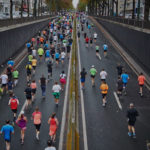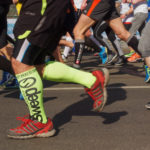ONE RUNNING SHOE IN THE GRAVE
New Studies on Older Endurance Athletes Suggest the Fittest Reap Few Health Benefits
By Kevin Helliker
Associated Press
Athletes compete in the World Triathlon Grand Final in Auckland, New Zealand, on Oct. 21. In a five-kilometer race Thanksgiving morning, Ralph Foiles finished first in his age group, earning the 56-year-old Kansan a winner’s medal.
Or was it a booby prize?
A fast-emerging body of scientific evidence points to a conclusion that’s unsettling, to say the least, for a lot of older athletes: Running can take a toll on the heart that essentially eliminates the benefits of exercise.
“Running too fast, too far and for too many years may speed one’s progress toward the finish line of life,” concludes an editorial to be published next month in the British journal Heart.
Until recently, the cardiac risk of exercise was measured almost exclusively by the incidence of deaths during races. For marathoners, that rate was one in 100,000—a number that didn’t exactly strike fear. Moreover, data showed that runners generally enjoyed enormous longevity benefits over nonrunners.
What the new research suggests is that the benefits of running may come to a hard stop later in life. In a study involving 52,600 people followed for three decades, the runners in the group had a 19% lower death rate than nonrunners, according to the Heart editorial. But among the running cohort, those who ran a lot—more than 20 to 25 miles a week—lost that mortality advantage.
Resisting baked goods is a special kind of torture for the 58-year-old founder and co-chief executive of Panera Bread. But Ron Shaich has adopted a workout that lets him enjoy his carbs in moderation. Melanie West has details on Lunch Break. Photo: Matthew Healey for The Wall Street Journal.
A growing number of older Americans are exploring martial arts such as tae kwon do and judo as a way to stay physically and mentally fit. With its kicks, punches and take downs, they are finding the sport brings a number of health benefits as well as increased confidence and respect.
Meanwhile, according to the Heart editorial, another large study found no mortality benefit for those who ran faster than 8 miles per hour, while those who ran slower reaped significant mortality benefits.
Those two studies—presented at recent medical conferences—follow the publication in recent months and years of several other articles finding cardiac abnormalities in extreme athletes, including coronary artery calcification of a degree typically found in the utterly sedentary.
Meghan Newcomer is a 32-year-old professional triathlete who has passed out during several races in recent years.
Opinion is nearly unanimous among cardiologists that endurance athletics significantly increases the risk of atrial fibrillation, an arrhythmia that is estimated to be the cause of one third of all strokes. “Chronic extreme exercise appears to cause excessive ‘wear-and-tear’ on the heart,” the editorial says.
Not everyone is lining up behind the new data. “The guys advancing the hypothesis that you can get too much exercise are manipulating the data,” said Paul Thompson, a former elite marathoner and nationally renowned sports cardiologist at Hartford Hospital. “They have an agenda.”
Sports cardiologist James O’Keefe, an author of the Heart paper, counters that Dr. Thompson is an exercise addict. “He, like many chronic exercise addicts, is the one with an agenda,” said Dr. O’Keefe, a sports cardiologist at Saint Luke’s Mid America Heart Institute in Kansas City. “My ‘agenda’ is my patients.”
Critics of the newer research say that the idea that running can harm the heart is based on research showing only an association—meaning that exercise may not be the cause of the problem. The note that in any large group of runners, high-mileage and high-speed athletes may be too few in number to be statistically significant.
Yet by all accounts, dosage is no less relevant to exercise than to any other medical treatment, and for years the endurance-athletics movement has prompted words of caution from none other than Kenneth Cooper, the Dallas physician widely credited with launching the aerobics movement nearly half a century ago. “If you are running more than 15 miles a week, you are doing it for some reason other than health,” said Dr. Cooper, adding that he suspects—without hard evidence—that extreme exercise can render a body more susceptible to cancer.
The most vocal proponent of cutting back for cardiac reasons is Dr. O’Keefe, a 56-year-old cardiologist and former elite athlete. From 1999 to 2004, he won outright the largest sprint distance triathlon in Kansas City, a testament not only to his athletic abilities but also to hours and hours of early- and late-hour training.
But a sense that this regimen was aging him prematurely, coupled with the mounting awareness of cardiac issues in extreme endurance athletes, prompted Dr. O’Keefe to slash his running to below 20 miles a week, never faster than eight minutes a mile.
Asked if he ever runs a five-kilometer race for time, he said, “Not for the past three years. After age 50, pushing too hard is probably not good for one’s heart or longevity.”
Meanwhile, Dr. O’Keefe’s fellow author on the upcoming Heart paper, Carl Lavie, continues racing at speeds slightly above what their editorial recommends. “I did a turkey day five-mile race in 38 minutes,” said Dr. Lavie, a cardiologist at the John Ochsner Heart and Vascular Institute in New Orleans. “I train slower than I race, and when I race I know the risks. That’s all we’re trying to do: Let people know the risks and make up their own minds.”
The conflict between pursuit of health and of athletic glory is particularly acute in Meghan Newcomer, a 32-year-old professional triathlete who in recent years passed out during several races, requiring acute medical attention and prompting her loved ones to ask her to slow down or retire. She has a promising medical career, after all: Why not quit competing?
Instead, after undergoing in-depth study at a Connecticut sports-medical clinic, she was told to triple her intake of sodium during races. Yet she was also told to slow down, advice that helped her this summer complete—without passing out—her first Ironman-distance triathlon.
The idea that serial marathoners may earn no cardiac advantage over couch potatoes will surely amuse serial viewers of “Seinfeld” reruns. But don’t expect the running boom to grind to a halt. Optimal health isn’t necessarily the Holy Grail, even for aging athletes.
“Even if I knew for sure that running fast had an element of risk, I don’t know that I would back down,” said Foiles, the 56-year-old runner who lives in a Kansas City suburb. “To finish at the front of my age group, yeah, that’s an inspiration.”
This article appeared November 27, 2012, on page D6 in the U.S. edition of The Wall Street Journal, with the headline: One Running Shoe in the Grave.








